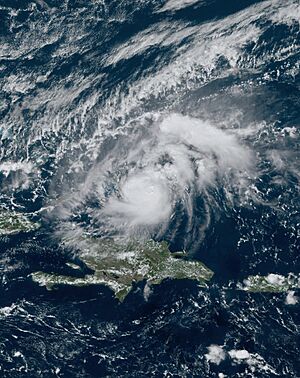Hurricane Oscar (2024) facts for kids

Hurricane Oscar passing north of Hispaniola on October 19
|
|
| Meteorological history | |
|---|---|
| Formed | October 19, 2024 |
| Category 1 tropical cyclone | |
| 1-minute sustained (SSHWS/NWS) | |
| Highest winds | 85 mph (140 km/h) |
| Lowest pressure | 986 mbar (hPa); 29.12 inHg |
| Overall effects | |
| Fatalities | ≥6 |
| Damage | Unknown |
| Areas affected |
|
|
Part of the 2024 Atlantic hurricane season |
|
Hurricane Oscar was a strong tropical cyclone that became a hurricane very quickly. It started as a tropical storm and then hit eastern Cuba as a Category 1 hurricane. Oscar was the fifteenth named storm and tenth hurricane of the 2024 Atlantic hurricane season.
This storm began from a tropical wave that moved off the coast of Africa on October 10. It didn't become a tropical storm until October 19. On that same day, Oscar grew much stronger very fast, becoming a Category 1 hurricane. It was the smallest hurricane ever recorded, with its strongest winds only reaching about 5 to 6 miles (8 to 10 kilometers) wide. Because of its small size, it was hard for weather experts to track its exact strength.
Contents
How Hurricane Oscar Formed and Grew
Weather experts first noticed a weather disturbance near West Africa on October 4. It slowly developed over several days. By October 10, it was called an "invest" (short for "investigation area"). This means the National Hurricane Center (NHC) was watching it closely.
The storm then moved into areas that made it harder to grow. Its chances of becoming a storm went up and down. But on October 19, north of Hispaniola, the storm quickly got stronger. It became a tropical storm and was named Oscar.
Oscar's Quick Growth and Small Size
Oscar then went through "rapid intensification". This means it gained strength very fast. A special plane called a "Hurricane Hunter" flew into the storm and found it was stronger than expected. By 6:00 PM UTC, it was a Category 1 hurricane with winds of 80 mph (130 km/h).
Oscar was a very small storm, almost like a group of strong thunderstorms. It made two landfalls as a hurricane. One was on Inagua with 80 mph (130 km/h) winds. The second was in Cuba.
Why Oscar Was Hard to Predict
A weather expert named Philippe Papin from the National Hurricane Center said that Oscar "kind of snuck up a little bit on us." This means it formed and grew faster than expected. Before Oscar formed, many computer models that predict weather stopped showing that a tropical storm would develop.
Oscar was the smallest hurricane ever recorded. Its strongest winds were only about 5 to 6 miles (8 to 10 kilometers) wide. Because it was so small, most satellites couldn't measure its exact strength very well. However, some special Canadian satellites showed that Oscar might have been even stronger, possibly a Category 2 or 3 hurricane, before it hit land.
What Happened During Oscar: Preparations and Impacts
Impacts in the Turks and Caicos Islands and Bahamas
On October 19, the government of The Bahamas issued a hurricane warning for the Turks and Caicos Islands and the Southeastern Bahamas. Airports in the Turks and Caicos Islands were closed. The Bahamian Disaster Risk Management (DRM) Authority also got its team ready.
Matthew Town felt the strong winds from the center of Oscar. On Grand Turk Island, the capital of the Turks and Caicos Islands, Oscar knocked down some trees. It also blew off parts of roofs from at least one house. Luckily, the tide was low, so the hurricane caused only minor flooding in the islands. A shelter in Inagua provided safety for 24 people.
After Oscar passed, the DRM Authority sent food to the southern islands that were affected.
Impacts in Cuba
The Government of Cuba issued a hurricane watch for the provinces of Guantánamo, Holguín, and Las Tunas on October 19. It was hard to share information about Oscar because of a country-wide power outage in Cuba.
As Oscar got closer to Cuba, a weather station in Cape Maisí recorded a wind gust of 103 km/h (64 mph). In Baracoa, large waves from the hurricane crashed over the seawall. This caused flooding along the city's coast. In the province of Guantánamo, some areas received more than 10 inches (25 cm) of rain.
Oscar caused serious damage in eastern Guantánamo. More than 1,000 homes were damaged. There was severe flooding in Baracoa, Imías, and Maisí. Many homes lost their roofs or partly collapsed. Many electrical lines were also knocked down. The heavy rain and strong winds caused landslides. These landslides also made it harder to fix the power outage. Sadly, at least six people died because of the storm.
See also
- Weather of 2024
- Tropical cyclones in 2024
- Timeline of the 2024 Atlantic hurricane season

